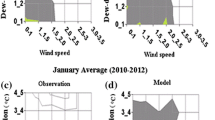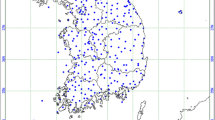Abstract
Several methods for visibility calculation for fog forecasting are discussed, including a method suggested by the authors. We use the WRF-ARW model to obtain the necessary meteorological information. The forecasts are estimated using data with a high spatial resolution from European Synoptic stations. The analysis of the methods shows a generally satisfactory quality of forecasts for this phenomenon.



Similar content being viewed by others
REFERENCES
S. P. Khromov and L. I. Mamontova, Meteorological Dictionary (Gidrometeoizdat, Leningrad, 1974) [in Russian].
L. T. Matveev, Atmospheric Physics (Gidrometeoizdat, Leningrad, 1965) [in Russian].
A. S. Zverev, Synoptical Meteorology (Gidrometeoizdat, Leningrad, 1977) [in Russian].
C. T. R. Wilson and J. J. Thomson, “Condensation of water vapour in the presence of dust-free air and other gases,” Proc. Roy. Soc., London 61 (369–377), 240–242 (1897).
S. Petersen, The Weather Analysis and Forecasting (Gidrometeoizdat, Leningrad, 1961) [in Russian].
M. A. Kohler and M. M. Richards, “Multicapacity basin accounting for predicting runoff from storm precipitation,” J. Geophys. Res. 67 (13), 5187–5197 (1962).
M. Neiburger and M. G. Wurtele, “On the nature and size of particles in haze, fog, and stratus of the Los Angeles region,” Chem. Rev. 44 (2), 321–335 (1949).
J. J. George, Weather Forecasting for Aeronautics (Academic Press, London, 1960).
N. V. Petrenko, “Improvement of the technique for forecasting advective fog and visibility in this fog,” Tr. Gidromet. SSSR, Is. 162, 34–45 (1975).
L. A. Klyuchnikova, “About the advective fog formation,” Tr. GGO, No. 60, 122 (1956).
Z. E. Babenko, Avtoref. Candidate’s Dissertation in Geography (Middle Asian Regional Research Institute named after V.A. Bugaev, Tashkent, 1961).
H. Koschmieder, “Measurements of visibility at danzig,” Mon. Weather. Rev. 58 (11), 439–444 (1930).
H. G. Houghton and W. H. Radford, On the Measurement of Drop Size and Liquid Water Content in Fogs and Clouds (Massachusetts Institute of Technology and Woods Hole Oceanographic Institution, Massachusetts, 1938).
D. B. Meison, G. T. Nikanorova, and V. S. Protopopova, Physics of Clouds (Gidrometeoizdat, Leningrad, 1961) [in Russian].
C. H. Bang, J. W. Lee, and S. Y. Hong, “Predictability experiments of fog and visibility in local airports over Korea using the WRF model,” J. KOSAE 24 (E2), 92–101 (2008).
M. T. Stoelinga and T. T. Warner, “Nonhydrostatic, mesobeta-scale model simulations of cloud ceiling and visibility for an East Coast winter precipitation event,” J. Appl. Meteorol. 38 (4), 385–404 (1999).
B. A. Kunkel, “Parameterization of droplet terminal velocity and extinction coefficient in fog models,” J. Clim. Appl. Meteorol. 23 (1), 34–41 (1984).
S. A. Rutledge and P. Hobbs, “The mesoscale and microscale structure and organization of clouds and precipitation in midlatitude cyclones. VIII: A model for the "seeder-feeder” process in warm-frontal rainbands," J. Atmos. Sci. 40 (5), 1185–1206 (1983).
J. R. Stallabrass, “Snow property measurement workshop,” in Proc. National Research Council Associate Committee on Geotechnical Research. Tech. memorandum (Canada, 1985), no. 140, p. 389–410
J. S. Marshall and W. M. Palmer, “The distribution of raindrops with size,” J. Meteorol. 5, 165–166 (1948).
P. E. Bieringer, M. Donovan, F. Robasky, D. A. Clark, and J. Hurst, “A characterization of NWP ceiling and visibility forecasts for the terminal airspace,” in 12th Conf. Aviation, Range, and Aerospace Meteorology, Atlanta, GA, 2006.
F. Wantuch, “Visibility and fog forecasting based on decision tree method,” Idojárás 105, 29–38 (2001).
J. A. Doran, P. J. Roohr, D. J. Beberwyk, G. R. Brooks, G. A. Gayno, R. T. Williams, J. M. Lewis, and R. J. Lefevre, “The MM5 at the Air Force Weather Agency—New products to support military operations,” in 8th Conf. Aviation, Range, and Aerospace Meteorology, Dallas, Texas, 1999.
W. C. Skamarock, J. B. Klemp, J. Dudhia, D. O. Gill, D. M. Barker, W. Wang, and J. G. Powers, A Description of the Advanced Research WRF Version 2. (Mesoscale and Microscale Meteorology Division, National Center for Atmospheric Research, Boulder, Colorado, USA, 2005). https://doi.org/10.5065/D68S4MVH
V. I. Bychkova, R. Yu. Ignatov, and K. G. Rubinshtein, “The analysis of thermal fluxes on surface from WRF-ARW model calculations in polar regions,” Uch. Zap. Ros. Gos. Gidromet. Univ., No. 20, 42–55 (2011).
M. M. Smirnova, Avtoref. Candidate’s Dissertation in Mathematics and Physics (Moscow State University, Moscow, 2014).
G. A. Grell, Y. H. Kuo, and R. J. Pasch, “Semiprognostic tests of cumulus parameterization schemes in the middle latitudes,” Mon. Weather. Rev. 119 (1), 5–31 (1991).
J. A. Milbrandt and M. K. Yau, “A multimoment bulk microphysics parameterization Part I. A proposed three-moment closure and scheme description,” J. Atmos. Sci. 62 (9), 3065–3081 (2005).
P. Bougeault and P. Lacarrere, “Parameterization of orography-induced turbulence in a mesobeta-scale model,” Mon. Weather. Rev. 117 (8), 1872–1890 (1989).
R. West, D. Crisp, and L. Chen, “Mapping transformations for broadband atmospheric radiation calculations,” J. Quant. Spectrosc. Radiat. Transfer 43 (3), 191–199 (1990).
M. B. Ek, K. E. Mitchell, Y. Lin, E. Rogers, P. Grunmann, V. Koren, Gayno, and J. D. Tarpley, “Implementation of Noah land surface model advances in the National Centers for Environmental Prediction operational mesoscale Eta model,” J. Geophys. Res.: Atmos. 108 (D22), 16 (2003).
ACKNOWLEDGMENTS
The work was partly supported by the Russian Foundation for Basic Research (grant nos. 16-05-00704, 18-35-00044 mol_a, and 16-05-00822 a).
Author information
Authors and Affiliations
Corresponding author
Additional information
Translated by O. Ponomareva
Rights and permissions
About this article
Cite this article
Zarochentsev, G.A., Rubinstein, K.G., Bychkova, V.I. et al. Comparison of Several Numerical Methods for Fog Prediction. Atmos Ocean Opt 32, 193–201 (2019). https://doi.org/10.1134/S1024856019020180
Received:
Revised:
Accepted:
Published:
Issue Date:
DOI: https://doi.org/10.1134/S1024856019020180




